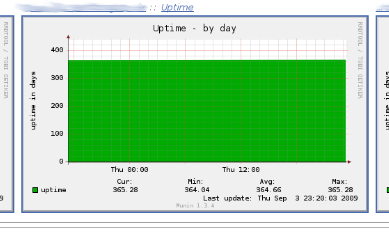Since a few weeks now I am in a new employer-employee relationship. I got a brand new Asus notebook. By accident I indeed booted M$ V1sta and cleanly restarted the computer. I then changed the BIOS password and was already happy to reboot, to enter the password and then install Debian GNU/Linux. The password??! It didn’t accept my password! Okay, after a few calls with the Asus customer support I really was very unpleased and we had to send this piece of cake back to the trader. I really can’t recommend the Asus support. That’s my personal experience. It’s now 4 weeks back we sent it in and we still didn’t get something back. So in the short term I got another Notebook, it’s a Sony Vaio VGN-FZ38M. Everything runs fine, the installation was straight forward and I had no glitches yet.
emil@xxx:~$ cat /etc/debian_version
lenny/sid
emil@xxx:~$ uname -a
Linux xxx 2.6.27.7 #1 SMP PREEMPT Wed Dec 3 09:26:13 CET 2008 i686 GNU/Linux
It’s specs are something like Intel Core 2 Duo T8100, 4 GB RAM, 200GB HD, WLAN 802.1 a/b/g/n, 15.4 WXGA – 1280×800 (that’s one obvious minus point), a NVIDIA GeForce 8400M GT GPU, Firewire, USB, Bluetooth and a Blue-ray disc drive.
For your info, here comes the output from lspci:
emil@xxx:~$ lspci
00:00.0 Host bridge: Intel Corporation Mobile PM965/GM965/GL960 Memory Controller Hub (rev 0c)
00:01.0 PCI bridge: Intel Corporation Mobile PM965/GM965/GL960 PCI Express Root Port (rev 0c)
00:1a.0 USB Controller: Intel Corporation 82801H (ICH8 Family) USB UHCI Controller #4 (rev 03)
00:1a.1 USB Controller: Intel Corporation 82801H (ICH8 Family) USB UHCI Controller #5 (rev 03)
00:1a.7 USB Controller: Intel Corporation 82801H (ICH8 Family) USB2 EHCI Controller #2 (rev 03)
00:1b.0 Audio device: Intel Corporation 82801H (ICH8 Family) HD Audio Controller (rev 03)
00:1c.0 PCI bridge: Intel Corporation 82801H (ICH8 Family) PCI Express Port 1 (rev 03)
00:1c.1 PCI bridge: Intel Corporation 82801H (ICH8 Family) PCI Express Port 2 (rev 03)
00:1c.2 PCI bridge: Intel Corporation 82801H (ICH8 Family) PCI Express Port 3 (rev 03)
00:1c.4 PCI bridge: Intel Corporation 82801H (ICH8 Family) PCI Express Port 5 (rev 03)
00:1d.0 USB Controller: Intel Corporation 82801H (ICH8 Family) USB UHCI Controller #1 (rev 03)
00:1d.1 USB Controller: Intel Corporation 82801H (ICH8 Family) USB UHCI Controller #2 (rev 03)
00:1d.2 USB Controller: Intel Corporation 82801H (ICH8 Family) USB UHCI Controller #3 (rev 03)
00:1d.7 USB Controller: Intel Corporation 82801H (ICH8 Family) USB2 EHCI Controller #1 (rev 03)
00:1e.0 PCI bridge: Intel Corporation 82801 Mobile PCI Bridge (rev f3)
00:1f.0 ISA bridge: Intel Corporation 82801HEM (ICH8M) LPC Interface Controller (rev 03)
00:1f.1 IDE interface: Intel Corporation 82801HBM/HEM (ICH8M/ICH8M-E) IDE Controller (rev 03)
00:1f.2 SATA controller: Intel Corporation 82801HBM/HEM (ICH8M/ICH8M-E) SATA AHCI Controller (rev 03)
00:1f.3 SMBus: Intel Corporation 82801H (ICH8 Family) SMBus Controller (rev 03)
01:00.0 VGA compatible controller: nVidia Corporation G86M [GeForce 8400M GT] (rev a1)
06:00.0 Network controller: Intel Corporation PRO/Wireless 4965 AG or AGN [Kedron] Network Connection (rev 61)
08:00.0 Ethernet controller: Marvell Technology Group Ltd. 88E8036 PCI-E Fast Ethernet Controller (rev 16)
09:03.0 CardBus bridge: Texas Instruments PCIxx12 Cardbus Controller
09:03.1 FireWire (IEEE 1394): Texas Instruments PCIxx12 OHCI Compliant IEEE 1394 Host Controller
09:03.2 Mass storage controller: Texas Instruments 5-in-1 Multimedia Card Reader (SD/MMC/MS/MS PRO/xD)
The WLAN device required to fetch the driver from this intel page und to put it in the /var/firmware/ directory.
emil@xxx:~$ ls -l /var/firmware/
total 184
-rw-r–r– 1 root root 187672 2008-12-03 14:56 iwlwifi-4965-2.ucode
My config fle for the network devices looks similar to the lines below, we have of course an encrypted WLAN and so I had to pass some more parameters to the config.
emil@xxx:~$ cat /etc/network/interfaces
# This file describes the network interfaces available on your system
# and how to activate them. For more information, see interfaces(5).
# The loopback network interface
auto lo
iface lo inet loopback
# The primary network interface
#allow-hotplug eth0
#iface eth0 inet dhcp
auto wlan0
iface wlan0 inet dhcp
pre-up (echo ‘Modprobing iwl4965’) && /sbin/modprobe iwl4965
post-down (echo ‘Removing iwl4965′) && /sbin/modprobe -r iwl4965
wpa-key_mgmt WPA-PSK
wpa-pairwise TKIP
wpa-group TKIP
wpa-psk your_Pre-Shared-Key
wpa-driver wext
wpa-key-mgmt WPA-PSK
wpa-proto WPA
wpa-ssid your_ESSID
This works for me, the screen resolution is sometimes a handicap and I would like a better battery uptime. But altogether this seems to be a good device without anything really ugly per my definition.
For further information about linux on notebooks etc you might have a look at tuxmobil.org.
HTH, Emil
EDIT: This notebook does not support Intel Vanderpool / VT technology !
This really is a big disappointment !


